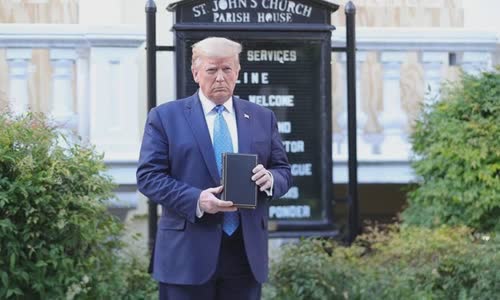Two weeks after the death of George Floyd, Trump has yet to meet the black community or come to Minneapolis, where the crisis broke out.
US presidents often visit the starting point of the national crisis, to listen to the people affected by the incident that brought the whole country to attention, and to call for national solidarity.

US President Donald Trump takes a photo in front of St Photo: Reuters
However, for President Donald Trump, he only expressed sympathy from behind the gates of the White House's fortified security, and mentioned the name of George Floyd, a black man killed by police.
As people across the country protested against police racial discrimination and violence, Trump walked to take photos at a church, after police sprayed tear gas to calm peaceful protesters near the White House.
Meanwhile, US Vice President Mike Pence organized a series of meetings with members of the African American community.
Instead, Pence's well-organized meetings are limited to or within Washington, with conservative colored people, religious leaders, and community leaders in the
Among the guests was Candace Owens, a political activist who once criticized Floyd as "an example of a lifelong criminal perpetrator, until the very last moment", adding that he was "not a human being".
President Trump said he used to talk to Floyd's family over the phone.
"He didn't even give me a chance to speak up. It was difficult. I tried to talk to him, but he was as if he kept pushing me out and didn't want to listen to what I said," said Philonise Floyd.
Commentator Vazquez said the White House's late solution to call for national solidarity could be carried out this week, in the form of a speech by the President.
In an interview with CNN on June 7, Housing and Urban Development Secretary Ben Carson, the only cabinet member who is black in the Trump administration, also said that everyone "will hear some details."
Since taking office until now, Trump has rarely had direct contact with those who disagree with him in the American public.
However, there have been American presidents who have met with civil rights activists and leaders, or at least visited massive protest areas where racial tensions stemmed.
President John Kennedy met civil rights leaders on the day activist Martin Luther King delivered the famous "I have a dream" speech.
Trump has also visited communities damaged by the national tragedy, but some trips were met with criticism and division, such as a visit to Dayton, Ohio and El Paso, Texas in August 2019.
Many politicians in the two cities did not welcome the President, while some victims of the shootings in El Paso said they did not want to see him.
In Dayton, when Trump visited, protesters gathered outside hospitals and downtown.



 Mary Kate McFarlane Brennan
Mary Kate McFarlane Brennan







